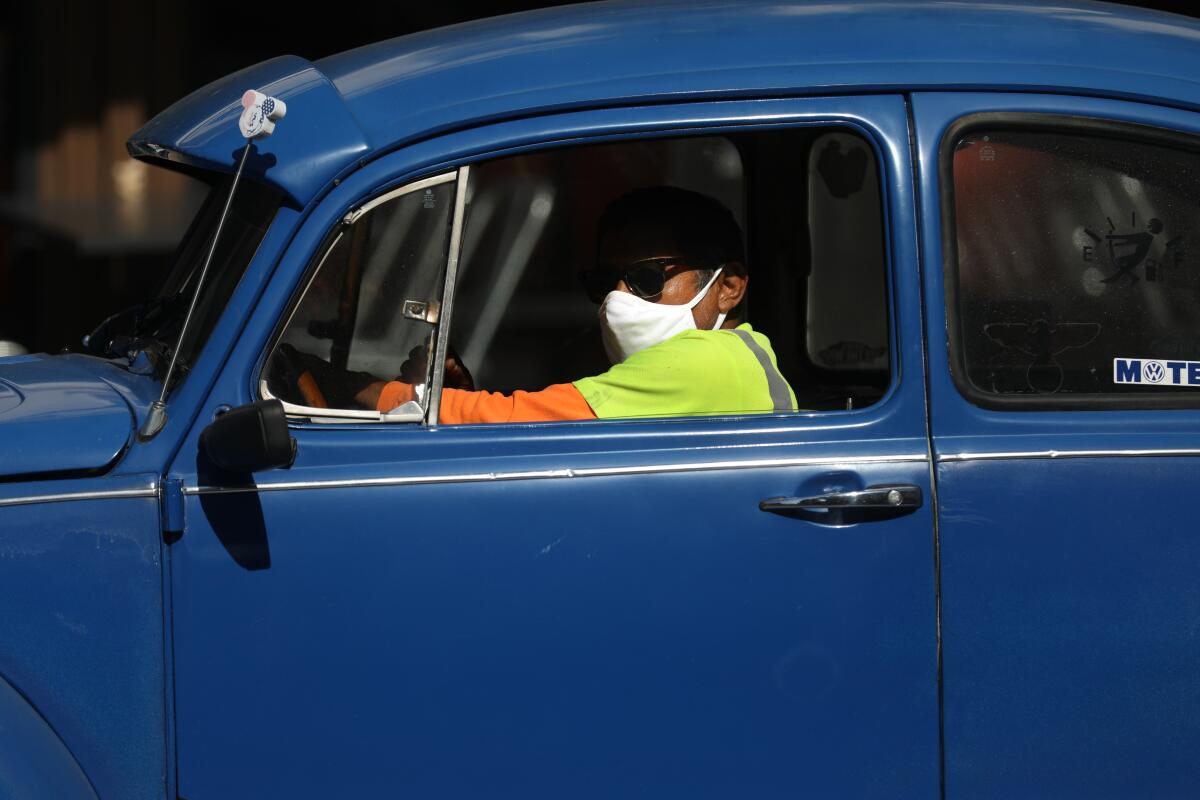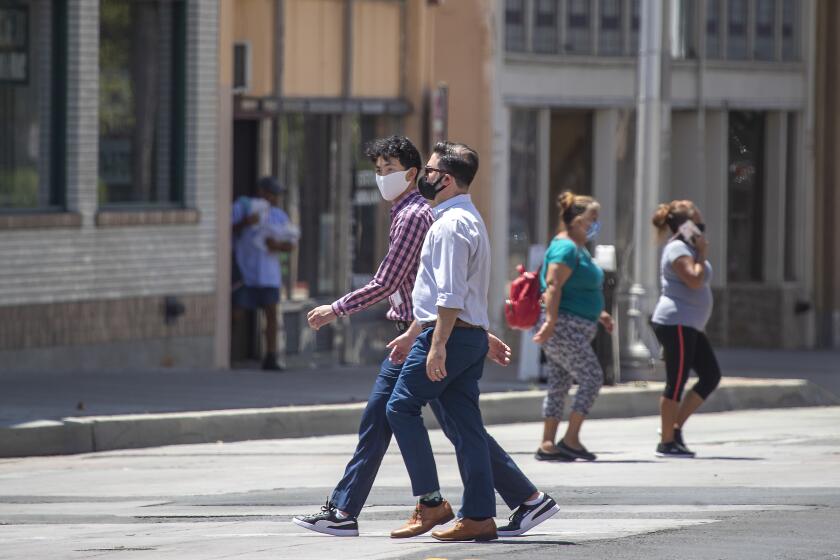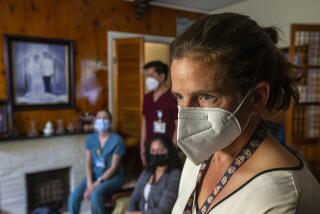Coronavirus deaths are now rising along with cases and hospitalizations. When will the wave crest?

- Share via
The surge of the coronavirus in California over the last month started with an explosion of new cases, then moved into hospitals that rapidly filled with patients and is now beginning to bring an increase in COVID-19 deaths.
The question now is how big the wave will get before it crests.
June turned out to be a grim month in the COVID-19 battle, with people beginning to socialize again in ways that allowed the virus to spread rapidly across communities. Hospitals are being hit hard as patients who were infected weeks ago are now getting sick enough to require medical care. Officials are hoping public behavior changed toward the end of June and early July, but they won’t know how that plays out for several more weeks.
California this week hit another troubling milestone Wednesday, recording the highest single-day COVID-19 death toll so far in the pandemic, with 149 fatalities reported, according to The Times’ California coronavirus tracker. An additional 137 deaths were reported Thursday, which would be the second-highest daily death toll in the pandemic.
Experts say deaths are a lagging indicator of coronavirus spread and probably reflect exposures to the virus that occurred four or five weeks earlier. Los Angeles County reported 48 deaths on Thursday, 61 on Wednesday, 45 on Tuesday and 50 on Monday. That’s substantially higher than the average of about 34 deaths per day reported in June.
Yet there are also a few signs of hope on the horizon.
Even as coronavirus-related hospitalizations reached all-time highs this week in L.A. County, they’ve been increasing at a slower rate in recent days, said Dr. Christine Ghaly, the county’s director of health services. Hospitalizations in the county topped out at a high of 2,037 on Tuesday before dropping to 1,995 Wednesday — a decline of 2%.
L.A. County officials began sounding the alarm last month, when the effective transmission rate of the coronavirus rose above 1, which means that, on average, each person infected with the virus transmitted it to more than one other person — setting the stage for a dramatic worsening of the pandemic.
The transmission rate has now fallen back to around 1. That’s good news, and if that rate remains steady, it’s likely that Los Angeles County will have an adequate supply of hospital beds through early August.
The hope is that actions taken by state and local governments over the last few weeks — closing down indoor dining and bars in most parts of California, requiring masks in public settings and shutting the beaches during the Fourth of July weekend — have slowed the outbreak.
Los Angeles Mayor Eric Garcetti warned this week that if the trend isn’t reversed soon, he would consider imposing stay-at-home rules once again. Los Angeles County Public Health Director Barbara Ferrer struck a more hopeful note.
“Nothing can be off the table in the pandemic,” she said. But, she added, “I hope we never have to go back to ‘safer at home.’”
She said there are sensible strategies that can be effective but offer far fewer negative impacts than reverting back to the strictest version of the stay-at-home order.
“We don’t have to be in crowds. We don’t have to have a party. We don’t have to get in a congested area. We don’t have to have close contact with people who aren’t in our household, unless it’s something that’s related to our work,” Ferrer said. “And I think if we can try to take those steps, it allows us to slow the spread.”
But for the short term, L.A. County should expect more bad news. Ferrer said it’s likely that daily coronavirus deaths will continue to go back up — a reflection of the worsened hospitalization numbers seen in recent weeks.
While hospitalizations of confirmed coronavirus patients have risen by 35% in L.A. County — and 28% in San Diego County — since Memorial Day, they’ve more than doubled in the suburban counties of Orange, Riverside and Ventura, and more than tripled in San Bernardino County.
The deteriorating conditions in Orange County have officials and health experts increasingly alarmed. On Wednesday, 691 people with confirmed coronavirus infections were hospitalized there; there were 300 on Memorial Day.
The spike has prompted hospitals countywide to begin to prepare for a surge of sick patients, said Orange County Health Care Agency Director Dr. Clayton Chau.
“These trends are very concerning, and we can expect the impact on our healthcare system to get worse in the coming days and weeks,” Chau said. “If the surge goes up to — or beyond — their capacity to mobilize resources, that will cause a real strain. A strain on the hospital systems means a strain on the ability to care for all patients, both COVID-19 and non-COVID-19 folks.”
The increase has prompted hospitals in the region to begin to prepare for a surge of sick patients, according to the director of the Orange County Health Care Agency.
The increase in hospitalizations comes as the number of new infections continues to rise in Orange County. On Thursday, health officials reported 1,292 new coronavirus cases, bringing the total number of infections to 21,517. Officials also reported 26 fatalities, pushing the county’s death toll past 400.
While those numbers help paint an overall picture of the virus’ toll on the region, Dr. Shruti Gohil, associate medical director of epidemiology and infection prevention at UC Irvine, has kept her eye trained specifically on hospitalization numbers, which experts say is a better indicator of severe cases in the community.
“If you look at the number of people who are requiring hospitalization, it gives you a better sense of the tip of the iceberg,” Gohil said. “There’s a larger portion of the population under that tip that indicates widespread community transmission.”
The number of people in intensive care units has also continued to climb steadily countywide, though not as quickly as overall hospitalizations. As of Wednesday, 234 patients were being treated in intensive care units. On Memorial Day, there were 119 patients in Orange County’s ICUs.
Gohil noted that Orange County’s increasing hospitalization numbers correlate directly with the loosening of stay-at-home restrictions that allowed indoor dining at restaurants to resume and bars to reopen last month.
“If you look carefully, it’s right within that incubation period,” Gohil said. “In my mind, the restaurants and bars reopening really sent this psychological message that things were OK. People started going out more, and it provided a more level playing field for this virus to infect people.”
Orange County reopened in-restaurant dining on May 23 and bars on June 12; Los Angeles County allowed indoor dining on May 29 and let bars reopen on June 19. Both counties were ordered by Gov. Gavin Newsom to close bars and indoor dining last week.
Hospitalizations noticeably worsened statewide starting in mid-June.
Orange County has been a hotbed of resistance to wearing masks, which might have also played a role. Local officials rescinded a mandatory mask-wearing rule on June 11; a week later, Newsom issued a statewide order to wear masks in public.
One big unanswered question is how much deaths will spike in the state. In L.A. County, the number of coronavirus-related deaths out of nursing homes has declined, thanks to better infection control practices and testing.
A greater percentage of infected people are younger adults, who are less likely to need hospitalization. But they could also end up spreading the infection to people highly susceptible to severe illness.
Garcetti said Wednesday that “more than 50% of the people who are testing positive in Los Angeles County are between 18 and 40 years of age.”
While “most young people are doing the right thing,” he said, “it’s clear that a lot of them are not.”
“This isn’t complicated: Do not get together with someone who’s not in your household,” he said. “These weeks are absolutely critical — critical to whether schools open, whether our economy and our economic recovery path continues. These weeks are critical for saving lives.”
Times staff writer Ryan Murphy contributed to this report.
More to Read
Sign up for Essential California
The most important California stories and recommendations in your inbox every morning.
You may occasionally receive promotional content from the Los Angeles Times.














